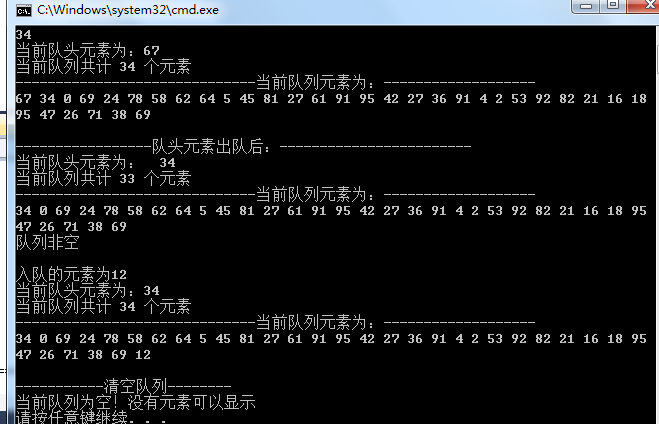佇列:出隊、入隊、銷燬、清空等
阿新 • • 發佈:2018-11-07
具體的佇列演算法實現程式碼。
將N個隨機數入隊。
實現出隊、再次入隊、列印佇列等方法。
記憶體洩露是個大問題。
記得free(p);p=NULL
p指標本身是在棧上儲存,不過p所指向的空間在堆上,所以需要程式設計師自行釋放,防止記憶體洩露。
free(p);之後p指標仍然存在,如果堆上原來指向的記憶體沒有被重寫,p還是可以的輸出的,以防p所指向的記憶體重寫,p相當於野指標,需要p=NULL;
原始碼如下:
#include<iostream> #include<stdlib.h> using namespace std; #define OK 1 typedef int QElemType; typedef int Status; typedef struct QNode{ QElemType data; struct QNode *next; };//定義節點 typedef struct{ struct QNode * rear;//尾指標 struct QNode * front;//頭指標 int Length; }LinkQueue;//定義佇列 Status InitQueue(LinkQueue &Q);//初始化佇列 Status EnQueue(LinkQueue &Q,QElemType e);//入隊在隊尾插入元素e Status ShowQueue(LinkQueue Q);//列印當前佇列元素 Status GetTop(LinkQueue Q,QElemType &e);//獲取當前隊頭元素,並用e返回 Status DeQueue(LinkQueue &Q);//出隊 Status IsEmptyQueue(LinkQueue Q);//判斷是否為空,隊空返回1。 Status ClearQueue(LinkQueue &Q);//清空佇列 Status DestroyQueue(LinkQueue &Q);//銷燬佇列 Status InitQueue(LinkQueue &Q){//傳地址,修改Q Q.rear=Q.front=(QNode *)malloc(sizeof(QNode));//指向頭結點 if(!Q.rear) cout<<"Error Overflow!"<<endl; Q.front->next=NULL; Q.Length=0; return 0; } Status EnQueue(LinkQueue &Q,QElemType e){ //在隊尾插入新的節點,需要開闢空間 QNode *p=(QNode *)malloc(sizeof(QNode)); if(!p) cout<<"分配記憶體失敗"<<endl; p->data=e; p->next=NULL; Q.rear->next=p; Q.rear=p; if(Q.front->next==NULL) Q.front->next=p; Q.Length++; return 0; } Status ShowQueue(LinkQueue Q){ QNode *p; p=Q.front->next;//p指向第一個元素 if(Q.front==Q.rear) { cout<<endl<<"當前佇列為空!沒有元素可以顯示"<<endl; return 0; } cout<<endl<<"當前佇列共計 "<<Q.Length<<" 個元素"<<endl; cout<<"------------------------------當前佇列元素為:-------------------"<<endl; while(p!=Q.rear) { cout<<p->data<<" "; p=p->next;//不能用p++ } cout<<p->data<<endl; return 0; } Status GetTop(LinkQueue Q,QElemType &e){ e=Q.front->next->data; return OK; } Status DeQueue(LinkQueue &Q){ if(Q.front==Q.rear) cout<<endl<<"佇列為空,沒有元素可以刪除!"<<endl; else { Q.front->next=Q.front->next->next; Q.Length--; } return OK; } Status IsEmptyQueue(LinkQueue Q){ if(Q.front==Q.rear) return 1; else return 0; } Status DestroyQueue(LinkQueue &Q){ if(Q.front!= NULL) { Q.rear=Q.front->next; free(Q.front); Q.front=Q.rear; //釋放一塊記憶體要做兩點:1.釋放指向它的指標。2.將該指標指向空 } return OK; } Status ClearQueue(LinkQueue &Q) { // 將Q清為空佇列 struct QNode *p,*q; Q.rear=Q.front; p=Q.front->next; Q.front->next=NULL;//只留下頭結點 while(p) { q=p; p=p->next; free(q); } return OK; } int main(int argc,char *argv[]){ LinkQueue Q;//結構體Q InitQueue(Q); QElemType e; e=rand()%100; int n;//隨機插入佇列元素的數目。 cout<<"請輸入佇列隨機元素數目:"<<endl; cin>>n; while(n--) { e=rand()%100; EnQueue(Q,e);//進隊n個元素 } GetTop(Q,e); cout<<"當前隊頭元素為:"<<e; ShowQueue(Q); DeQueue(Q); cout<<endl<<"-----------------隊頭元素出隊後:------------------------"<<endl; GetTop(Q,e); cout<<"當前隊頭元素為: "<<e; ShowQueue(Q); if(!IsEmptyQueue(Q)) cout<<"佇列非空"<<endl; e=rand()%50; cout<<endl<<"入隊的元素為"<<e<<endl; EnQueue(Q,e);//再次入隊 GetTop(Q,e); cout<<"當前隊頭元素為:"<<e; ShowQueue(Q); //清空 cout<<endl<<"-----------清空佇列--------"; DestroyQueue(Q); ShowQueue(Q); return 0; }
實現結果截圖:

